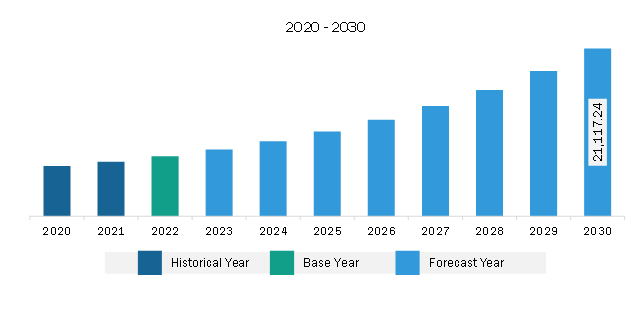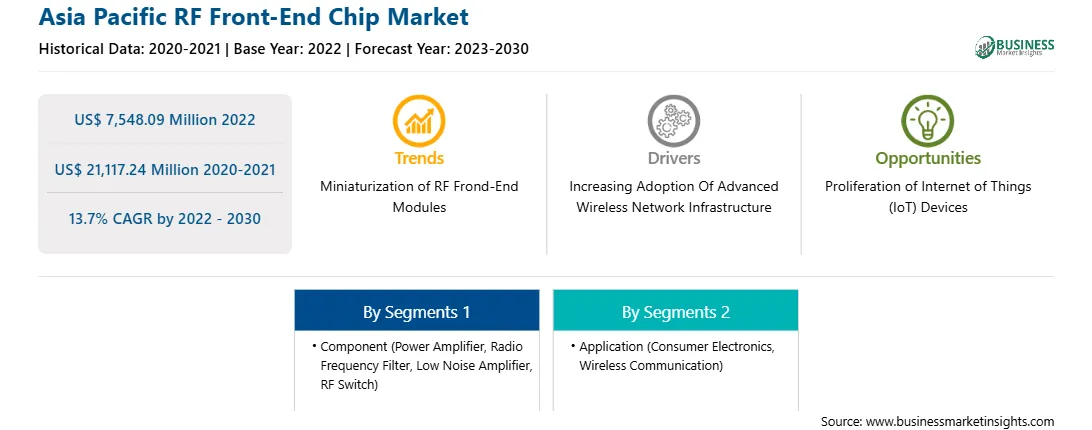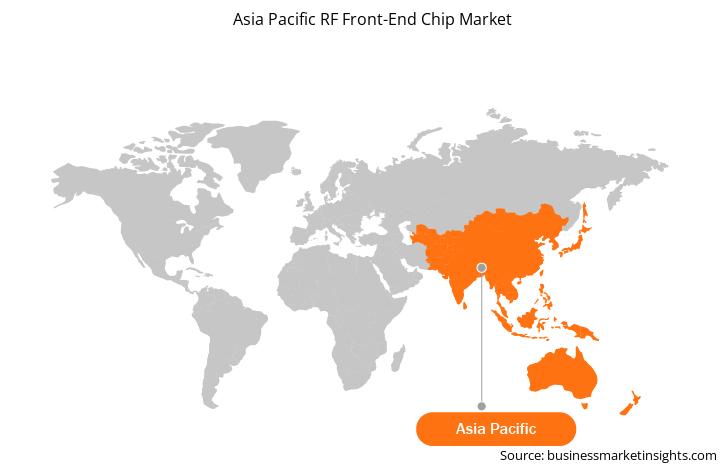Asia Pacific RF Front-End Chip Market
No. of Pages: 143 | Report Code: BMIRE00030856 | Category: Electronics and Semiconductor
No. of Pages: 143 | Report Code: BMIRE00030856 | Category: Electronics and Semiconductor
The Asia Pacific RF front-end chip market was valued at US$ 7,548.09 million in 2022 and is expected to reach US$ 21,117.24 million by 2030; it is estimated to register a CAGR of 13.7% from 2022 to 2030.
Emergence of 5G Technology Boosts Asia Pacific RF Front-End Chip Market
5G technology offers significantly faster speeds compared to previous generations of mobile networks. Due to this, the adoption of 5G technology is increasing. According to the Global Mobile Suppliers Association (GSA), there were 1.15 billion 5G subscribers at the end of 2022. Further, massive multiple input, multiple output (M-MIMO) is ready to be the architecture of choice for nascent 5G network radios, as required spectral efficiency and transmission reliability qualities are inherent to this architecture. The emergence of 5G poses various challenges. 5G designers must massively increase the number of instantaneous transceiver channels operating in multiple bands while squeezing all the necessary hardware into a form factor that is as large as or smaller than in the previous 4G generation's equipment. The growth of 5G technology requires high RF bandwidth and, therefore, an increase in the number of components such as acoustic filters, RF switches, and power amplifiers integrated into a few RF front-end chip. With the emergence of 5G, there is a growth in the number of RF radio receivers and transmitters creating massive growth opportunity for the growth of the RF front-end chip market.
Asia Pacific RF Front-End Chip Market Overview
Asia Pacific RF front-end chip market is segmented into Australia, India, China, Japan, South Korea, and the Rest of Asia Pacific. Asia Pacific is expected to register strong growth in the RF front-end chip market due to increased demand for high-speed data connectivity, expanding smartphone penetration, and the expansion of communication networks. The development of 5G networks primarily drives the Asia Pacific RF front-end chip market. Countries such as South Korea, China, and Japan are at the forefront of 5G adoption, increasing the demand for RF switches that can handle the complexities of high-frequency bands and advanced communication protocols. According to the Internet World Stats, in Asia Pacific, there are 2,934,186,678 Internet users and a 67.4% penetration rate as of July 2022. Also, as of November 2023, China having the world's first ultra-high-speed next-generation internet backbone. Such proliferation of high-speed internet connectivity is projected to drive the demand for RF front-end chips, as it helps to amplify, filter, and transmit the signal through the antenna. It also handles complex signals and higher frequencies associated with high-speed internet.
The adoption of smartphones in Asia Pacific is growing rapidly. For example, according to the Mobile Economy APAC 2023 Report, released in June 2023 at an event organized by the GSMA and Singtel in Singapore, Mobile subscribers will increase by 400 million between 2022 and 2030, reaching 2.11 billion. Smartphone use is expected to reach 94% by 2030, up 18% from 2022, due to lower device costs and better digital literacy. In today's mobile devices, a complex circuit is responsible for transforming information from near-zero frequency band signals that are used to transport information and data into radio signals that are received or delivered over the air. RF front-end chip plays an important role in smartphones. Thus, the growing adoption of smartphones in the region propels the RF front-end chip market.
Asia Pacific RF Front-End Chip Market Revenue and Forecast to 2030 (US$ Million)

Strategic insights for the Asia Pacific RF Front-End Chip provides data-driven analysis of the industry landscape, including current trends, key players, and regional nuances. These insights offer actionable recommendations, enabling readers to differentiate themselves from competitors by identifying untapped segments or developing unique value propositions. Leveraging data analytics, these insights help industry players anticipate the market shifts, whether investors, manufacturers, or other stakeholders. A future-oriented perspective is essential, helping stakeholders anticipate market shifts and position themselves for long-term success in this dynamic region. Ultimately, effective strategic insights empower readers to make informed decisions that drive profitability and achieve their business objectives within the market.

| Report Attribute | Details |
|---|---|
| Market size in 2022 | US$ 7,548.09 Million |
| Market Size by 2030 | US$ 21,117.24 Million |
| Global CAGR (2022 - 2030) | 13.7% |
| Historical Data | 2020-2021 |
| Forecast period | 2023-2030 |
| Segments Covered |
By Component
|
| Regions and Countries Covered | Asia-Pacific
|
| Market leaders and key company profiles |
The geographic scope of the Asia Pacific RF Front-End Chip refers to the specific areas in which a business operates and competes. Understanding local distinctions, such as diverse consumer preferences (e.g., demand for specific plug types or battery backup durations), varying economic conditions, and regulatory environments, is crucial for tailoring strategies to specific markets. Businesses can expand their reach by identifying underserved areas or adapting their offerings to meet local demands. A clear market focus allows for more effective resource allocation, targeted marketing campaigns, and better positioning against local competitors, ultimately driving growth in those targeted areas.

Asia Pacific RF Front-End Chip Market Segmentation
The Asia Pacific RF front-end chip market is categorized into component, application, and country.
Based on component, the Asia Pacific RF front-end chip market is segmented into power amplifier, radio frequency filter, low noise amplifier, RF switch, and others. The power amplifier segment held the largest market share in 2022.
Based on application, the Asia Pacific RF front-end chip market is segmented into consumer electronics, wireless communication, and others. The consumer electronics segment held the largest market share in 2022.
By country, the Asia Pacific RF front-end chip market is segmented into China, Japan, India, South Korea, Australia, and the Rest of Asia Pacific. China dominated the Asia Pacific RF front-end chip market share in 2022.
Broadcom Inc, Infineon Technologies AG, Microchip Technology Inc, Murata Manufacturing Co Ltd, NXP Semiconductors NV, Qorvo Inc, Skyworks Solutions Inc, STMicroelectronics NV, TDK Corp, and Texas Instruments Inc are some of the leading companies operating in the Asia Pacific RF front-end chip market.
The Asia Pacific RF Front-End Chip Market is valued at US$ 7,548.09 Million in 2022, it is projected to reach US$ 21,117.24 Million by 2030.
As per our report Asia Pacific RF Front-End Chip Market, the market size is valued at US$ 7,548.09 Million in 2022, projecting it to reach US$ 21,117.24 Million by 2030. This translates to a CAGR of approximately 13.7% during the forecast period.
The Asia Pacific RF Front-End Chip Market report typically cover these key segments-
The historic period, base year, and forecast period can vary slightly depending on the specific market research report. However, for the Asia Pacific RF Front-End Chip Market report:
The Asia Pacific RF Front-End Chip Market is populated by several key players, each contributing to its growth and innovation. Some of the major players include:
The Asia Pacific RF Front-End Chip Market report is valuable for diverse stakeholders, including:
Essentially, anyone involved in or considering involvement in the Asia Pacific RF Front-End Chip Market value chain can benefit from the information contained in a comprehensive market report.